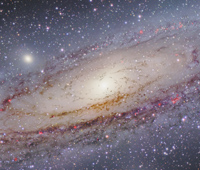
click here for a 60% size 2349x1543 (2669KB)
Click on the image below to for a 100% view of the central part (714KB)

Here you find a black and white image (923KB - slightly more stretched).

| Optics | Borg ED101 at f/5.7 |
| Camera | STL11000M |
| Filters | Baader Halpha HaLRGB |
| Date | Sept 22 -Dez 09, 2009 |
| Location | Antares Observatory |
| Sky Conditions | mag 4-5 sky |
| Exposure | L(Ha-R)GB = 630,(280,270),255,255min total: 28h 10min 15min (20min Ha) subexposures |
| Programs used | CCDStack, Registar, Photoshop CS4 |
The Andromeda Galaxy (Messier Number 31) is probably the most famous galaxy. Because the distance to our home
is relatively small ('only' about 2.5 million light-years) it appears as the largest spiral galaxy in the sky.
It is thought that the structure of our own galaxy looks somewhat similar to M31. Messier 31 also has several
satellit galaxies, the brightest ones are m32 and m110,
seen on the picture beside.
In a clear and moonless night it is one of the farthest objects visible to the naked eye. About one trillion(!)
stars let the galaxy appear as a faint smudge in the constallation of Andromeda. They also let the galaxy be the
brightest messier galaxy: Apparent magnitude 3.4. Long exposed images reveal a diameter of more than six times the
dimension of the full moon. A more recent study
concludes that the Andromeda galaxy and the Milkyway galaxy are about equal in mass whereas the diameter of M31 is
about 50 percent larger.
More information about this object can be found here.
See the proper motion of stars in this area here.

click here for a 60% size 2349x1543 (2669KB)
Click on the image below to for a 100% view of the central part (714KB)

Here you find a black and white image (923KB - slightly more stretched).